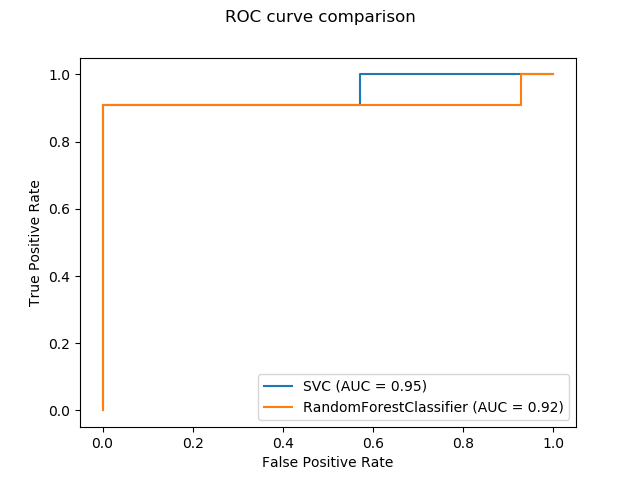sklearn.ensemble.StackingClassifier¶
class sklearn.ensemble.StackingClassifier(estimators, final_estimator=None, *, cv=None, stack_method='auto', n_jobs=None, passthrough=False, verbose=0)
带有最终分类器的估计器堆栈。
堆叠泛化包括堆叠个别估计器的输出,并使用分类器来计算最终的预测。叠加允许使用每个估计器的强度,使用它们的输出作为最终估计器的输入。
注意,estimators_是在完整的X上拟合而来的,而final_estimator_是通过使用cross_val_predict对基础估计器进行交叉验证的预测来进行训练的。
0.22版本新功能。
在用户指南中阅读更多内容。
| 参数 | 说明 |
|---|---|
| estimators | list of (str, estimator) 将被堆叠在一起的基础估计器。列表中的每个元素都被定义为一个字符串元组(即名称)和一个 estimator实例。可以使用set_params将评估器设置为“drop”。 |
| final_estimator | estimator, default=None 一个分类器,它将被用来组合基础估计器。默认的分类器是 LogisticRegression。 |
| cv | int, cross-validation generator or an iterable, default=None 确定 cross_val_predict中用于训练final_estimator的交叉验证拆分策略。cv可能的输入有:- None,使用默认的5折交叉验证。 - Integer, 用于指定(分层的)K-Fold中的折叠数。 - 用作交叉验证生成器的对象。 - 一个可迭代的产生的训练、测试分割。 对于 integer/None,如果估计器是一个分类器,并且y是二进制的或多类的,则使用StratifiedKFold。所有其他情况下,使用K-Fold。参考用户指南,了解这里可以使用的各种交叉验证策略。 注意:如果训练样本的数量足够大,那么分割的数量再大也没有什么好处。事实上,训练时间会增加。cv不是用于模型评估,而是用于预测。 |
| stack_method | {‘auto’, ‘predict_proba’, ‘decision_function’, ‘predict’}, default=’auto’ 为每个基本估计器调用的方法。它可以是: - 如果是“auto”,它将对每个估计器按相应顺序调用“predict_proba”、“decision_function”或“predict”。 - 否则,'predict_proba'、'decision_function'或'predict'中的一个。如果估计器没有实现该方法,它将产生一个错误。 |
| n_jobs | int, default=None 所有并行 estimators fit作业数量。除非在joblib.parallel_backend中,否则None表示是1。-1表示使用所有处理器。参见Glossary了解更多细节。 |
| passthrough | bool, default=False 当为 False时,只使用估计器的预测作为final_estimator的训练数据。当为真时,final_estimator将在预测和原始训练数据上进行训练。 |
| verbose | int, default=0 冗余水平。 |
| 属性 | 说明 |
|---|---|
| classes_ | ndarray of shape (n_classes,) 类标签。 |
| estimators_ | list of estimators 估计器参数的元素,已在训练数据上拟合。如果一个估计器被设置为“drop”,那么它将不会出现在 estimators_中。 |
| named_estimators_ | Bunch属性来按名称访问任何适合的子估计器。 |
| final_estimator_ | estimator 给出估计器的输出来预测的 estimators_。 |
| stack_method_ | list of str 每个基估计器使用的方法。 |
注意
当每个估计器使用predict_proba时(即大多数时候stack_method='auto',或者stack_method='predict_proba'),在出现二进制分类问题时,每个估计器预测的第一列将被删除。事实上,这两个特征将是完全共线的。
参考文献
Wolpert, David H. “Stacked generalization.” Neural networks 5.2 (1992): 241-259.
实例
>>> from sklearn.datasets import load_iris
>>> from sklearn.ensemble import RandomForestClassifier
>>> from sklearn.svm import LinearSVC
>>> from sklearn.linear_model import LogisticRegression
>>> from sklearn.preprocessing import StandardScaler
>>> from sklearn.pipeline import make_pipeline
>>> from sklearn.ensemble import StackingClassifier
>>> X, y = load_iris(return_X_y=True)
>>> estimators = [
... ('rf', RandomForestClassifier(n_estimators=10, random_state=42)),
... ('svr', make_pipeline(StandardScaler(),
... LinearSVC(random_state=42)))
... ]
>>> clf = StackingClassifier(
... estimators=estimators, final_estimator=LogisticRegression()
... )
>>> from sklearn.model_selection import train_test_split
>>> X_train, X_test, y_train, y_test = train_test_split(
... X, y, stratify=y, random_state=42
... )
>>> clf.fit(X_train, y_train).score(X_test, y_test)
0.9...
方法
| 方法 | 说明 |
|---|---|
decision_function(X) |
使用final_estimator_.decision_function对X中的样本预测决策函数 |
fit(X[, y, sample_weight]) |
拟合估计器。 |
fit_transform(X[, y, sample_weight]) |
拟合估计器和变换数据集。 |
get_params([deep]) |
从集成中得到估计器的参数。 |
predict(X, **predict_params) |
预测X的目标值。 |
predict_proba(X) |
使用final_estimator_.predict_proba预测X的类概率。 |
score(X, y[, sample_weight]) |
返回给定测试数据和标签的平均精度。 |
set_params(**params) |
从集成中设置估计器的参数。 |
transform(X) |
返回每个估计器X的类标签或概率。 |
__init__(estimators, final_estimator=None, *, cv=None, stack_method='auto', n_jobs=None, passthrough=False, verbose=0)
初始化self。有关准确的签名,请参见help(type(self))。
decision_function(X)
使用final_estimator_.decision_function对X中的样本预测决策函数。
| 参数 | 说明 |
|---|---|
| X | {array-like, sparse matrix} of shape (n_samples, n_features) 训练向量,其中n_samples为样本数量,n_features为特征数量。 |
| 返回值 | 说明 |
|---|---|
| decisions | ndarray of shape (n_samples,), (n_samples, n_classes), or (n_samples, n_classes * (n_classes-1) / 2) 决策函数计算最终的估计器。 |
fit(X, y, sample_weight = None)
拟合估计器。
| 参数 | 说明 |
|---|---|
| X | {array-like, sparse matrix} of shape (n_samples, n_features) 训练向量,其中n_samples为样本数量,n_features为特征数量。 |
| y | array-like of shape (n_samples,) 目标值。 |
| sample_weight | array-like of shape (n_samples,), default=None 样本权重。如果没有,那么样本的权重相等。当在每个节点中搜索分割时,将忽略创建具有净零权值或负权值的子节点的分割。在分类的情况下,如果分割会导致任何一个类在任一子节点中具有负权值,那么分割也将被忽略。 |
| 返回值 | 说明 |
|---|---|
| self | object |
fit_transform(X, y=None, sample_weight=None)
拟合数据,然后转换它。
使用可选参数fit_params将transformer与X和y匹配,并返回X的转换版本。
| 参数 | 说明 |
|---|---|
| X | {array-like, sparse matrix} of shape (n_samples, n_features) 训练向量,其中n_samples为样本数量,n_features为特征数量。 |
| y | ndarray of shape (n_samples,), default=None 目标值。 |
| **fit_params | dict 其他拟合参数。 |
| 返回值 | 说明 |
|---|---|
| X_new | ndarray array of shape (n_samples, n_features_new) 转化后的数组。 |
get_params(deep=True)
从集成中得到估计器的参数。
| 参数 | 说明 |
|---|---|
| deep | deep : bool, default = True 将其设置为True将获得各种分类器以及分类器的参数。 |
property n_features_in_
fit 过程中可见的特征数量。
predict(X, **predict_params)
预测X的目标值。
该方法适用于简单估计器和嵌套对象(如pipline)。后者具有形式为<component>_<parameter>的参数,这样就可以更新嵌套对象的每个组件。
| 参数 | 说明 |
|---|---|
| X | {array-like, sparse matrix} of shape (n_samples, n_features) 估计器参数训练向量,其中n_samples为样本数量,n_features为特征数量。 |
| **predict_params | dict of str -> obj 由 final_estimator调用的predict的参数。请注意,这可能用于从一些使用return_std或return_cov的估计器返回不确定性。请注意,它只会在最终的估计器中考虑不确定性。 |
| 返回值 | 说明 |
|---|---|
| y_pred | ndarray of shape (n_samples,) or (n_samples, n_output) 预测后的目标值。 |
predict_proba(X)
使用final_estimator_.predict_proba预测X的类概率
| 参数 | 说明 |
|---|---|
| X | {array-like, sparse matrix} of shape (n_samples, n_features) 训练向量,其中n_samples为样本数量,n_features为特征数量。 |
| 返回值 | 说明 |
|---|---|
| probabilities | ndarray of shape (n_samples, n_classes) or list of ndarray of shape (n_output,) 输入样本的类概率。 |
score(X, y, sample_weight=None)
返回给定测试数据和标签的平均精度。
在多标签分类中,这是子集精度,这是一个苛刻的指标,因为你需要对每个样本正确预测每个标签集。
| 参数 | 说明 |
|---|---|
| X | array-like of shape (n_samples, n_features) 测试样本。 |
| y | array-like of shape (n_samples,) or (n_samples, n_outputs)X的正确标签 |
| sample_weight | array-like of shape (n_samples,), default=None 样本权重。 |
| 返回值 | 说明 |
|---|---|
| score | float self.predict(X) 关于y的平均准确率。 |
set_params(**params)
从集成中设置估计器的参数。
有效的参数键可以用get_params()列出。
| 参数 | 说明 |
|---|---|
| **params | keyword arguments 使用例如 set_params(parameter_name=new_value)的特定参数。此外,为了设置堆料估算器的参数,还可以设置叠加估算器的单个估算器,或者通过将它们设置为“drop”来删除它们。 |
transform(X)
返回每个估计量X的类标签或概率。
| 参数 | 说明 |
|---|---|
| X | {array-like, sparse matrix} of shape (n_samples, n_features) 训练向量,其中 n_samples为样本数量,n_features为特征数量。 |
| 返回值 | 说明 |
|---|---|
| y_preds | ndarray of shape (n_samples, n_estimators) or (n_samples, n_classes * n_estimators) 每个估计器的预测输出。 |





